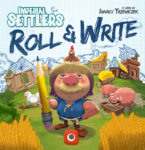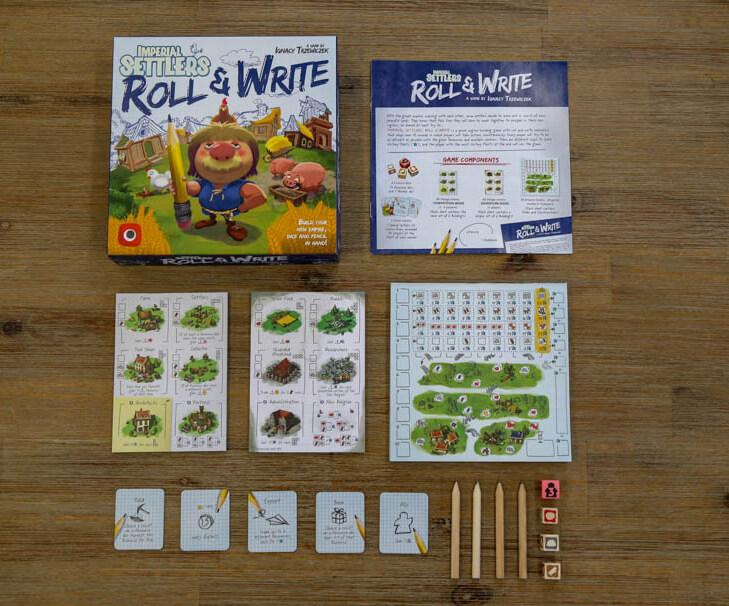Imperial Settlers: Roll & Write (Boardgame)
 Use actions and resources to build up your kingdom in Imperial Settlers: Roll & Write. Convert the resources shown on the dice directly into points or use them to invest in buildings to gain even more resources in future rounds. Roll & Write games of this sort are a great family gaming option since all players take their turn at once. This particular game stands out because it also has solo mode that can be played as a campaign, where the game changes up slightly each time, keeping each game fresh.
Use actions and resources to build up your kingdom in Imperial Settlers: Roll & Write. Convert the resources shown on the dice directly into points or use them to invest in buildings to gain even more resources in future rounds. Roll & Write games of this sort are a great family gaming option since all players take their turn at once. This particular game stands out because it also has solo mode that can be played as a campaign, where the game changes up slightly each time, keeping each game fresh.
Imperial Settlers: Roll & Write
Designer: Ignacy Trzewiczek
Publisher: Portal Games
Players:1-4
Ages: 10+
Time: 30minutes
(review copy provided by publisher)
The Roll & Write genre has been taking the boardgame community by storm. There are now a wealth of games out there that use the mechanism. The main idea is similar to the popular game, Yahtzee. A player rolls dice, perhaps multiple times, and then marks off spots on their scoresheet which are worth points at the end of the game. Where the Roll & Write genre differs, is that the dice are rolled and then all players simultaneously use the same dice to mark off spots on their scorecard. The game doesn’t depend on how well a person can roll, since all players share the same numbers each round.

Imperial Settlers: Roll & Write has players filling out their scorecard through the use of two types of resources. Any given round (there are 10) four dice are rolled. Three of them provide one resource (food, wood, stone, or gold – a wildcard) and the other dictates how many actions players can take that round. Each action allows players to cross off one box on their score card. However, most boxes also contain one or more resources, and players must also use up the requisite resources to cross off that box. For example, if the roll was 3 actions, 2 wood, and 1 stone, a player could cross out one box containing 2 wood, one box containing 1 stone, and one empty box. The main source of points is simply crossing out more and more boxes of each type of good, scoring more points the more boxes that are crossed off in that row.
Where Imperial Settlers: Roll & Write stands out from the many other games in the genre is the opportunity to build buildings and the option to gain resources through a “field” of resources in addition to those shown on the dice. The resource field is straightforward. One row of scoring boxes can be crossed out to open up various “bridges” which give players access to a field of different goods. Once a bridge has been “built”, players can then spend an action to cross out a spot on the field and gain the resources shown. Players still have to spend actions to then use those resources to cross off other boxes. The first few bridges only require actions to open up, with later bridges also requiring resources to unlock. However, the higher-end fields also contain more resources and could thus provide two or even three resources for one “gathering” action.
The second option for players to improve their resource “production” is to build special buildings. These typically take three actions to build (some boxes also require resources) and grant a special ability – primarily extra goods or actions depending on what it is rolled on the dice. Two other buildings simply grant points at the end of the game. Buildings have one additional “kicker” to their abilities. Each building is associated with a specific shape (think Tetris piece.) As players cross off boxes on the standard resource tracks (stone,wood, food, bridges) they gain more and more points, but the crossed off boxes also serve as a “building area.” By building walls around boxes in the shape of a specific building, that building’s power is increased by one. Thus, a building providing 1 action a round now will produce 2 actions if the associated shape has been created. Note, building shapes cannot overlap. This is slightly harder than it looks, as the shapes must keep a specific orientation and will thus limit which options are available. Buildings are particularly important in the standard game, as one “building” provides no special abilities but can be built (outlined) for a whopping 7 points each. Creating buildings add another dimension to the game because players aren’t going to just rush along a particular scoring track as fast as possible. They may want to spread out their efforts in order to open up options for a building area.
The second unique aspect of Imperial Settlers Roll & Write is the campaign game. A typical game has players using a base scorepad (with the four main resource tracks as well as the various resource fields) and an “auxiliary” gamepad listing the six basic buildings. These are used for any multiplayer game. However, in the same box is a special pad of paper made out of 48 different sheets, each containing a different set of buildings. They are designed for a player to go through in sequence in a series of solo games, making a sort of “campaign” mode to the solo game. While the sheets don’t create much of an ongoing story, they provide some interesting building options, including new scoring options and the ability to reroll some dice at the start of the round.
Verdict:
With so many roll & write games on the market, it is hard to stand out from the pack. The standard Imperial Settlers Roll & Write game is interesting, but I’m not sure if it will hold my long-term interest. However, the addition of the solo mode makes it far more intriguing. Paging through the campaign/adventure there doesn’t seem to be many repeat buildings. Sure, there are some that do the same thing with wood that others do with stone, etc… but each set gives a bit of varied play. In addition, the designers have a website where players can suggest their own buildings (as well as print out additional score pads) for others to try out. Gamers looking for a good, family-level roll & write should get good use of the game. However, the sheer volume of games in the roll & write genre creates a pretty competitive scene. Where this one stands out the most is in its solo-play “adventure” mode, which essentially provides 48 different ways to play.
Kid Factor
No reading here (aside from building powers, which are easily explained) and everything is entirely age-appropriate. I would hazard even the youngest players would enjoy the game. It would primarily be a matter of accurately tracking the resources spent in a specific turn. However, players with a bit of strategic planning will tend to have the edge in pulling out a win.





Discussion Area - Leave a Comment